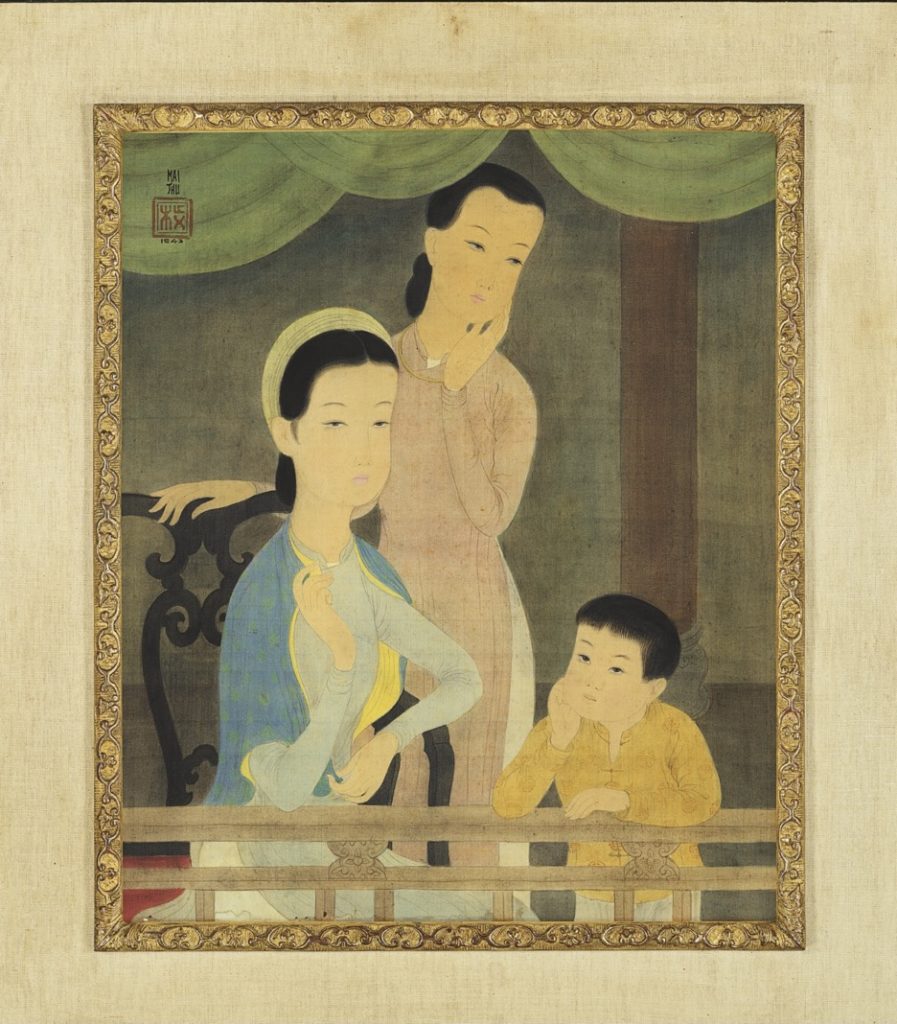Mai Thu, 1943, « L’élégante Interrogation » (The Elegant Questioning), or Will All The Images Disappear?
The interior bears witness to the somewhat old-fashioned austerity of the wealthy residences in Hanoi or Hue, at the time. The hardwood armchair, mixed with French influence, the opulent horizontal drapery, the solid wood column with its base carved in Thanh-Hoa stone are not enough to soften this Confucian rigor.

The artist isolates us from the scene by imposing in the foreground the top of a balustrade, certainly openwork and carved with floral motifs, but frontal, over the whole width of the painting. As if he was holding us at a distance so that we beg for his attention. The molded and gilded frame – which the Romanet gallery used at that time – circumscribes and enhances the subject. Later, Mai Thu would make his patiently crafted and lacquered frames into more than just accessories, they would reveal the work.
Two ao dai dress the women. One of them is wearing a Tonkinese headdress is doubled with a flowered shawl in two-tone silk velvet. The other with her loose hair who wears a torque is simpler. Both are made in the type created in the 1930s in Hanoi by Nguyen Cat Tuong (1912-1946), alias LeMur, an innovative couturier and artist who also graduated from the Indochina School of Fine Arts (in 1933). A member of the nationalist literary group (founded in 1932), the Tu Luc Van Doan (Autonomous Literary Group), Lemur did not suggest a simple fashion but offered to the urban Vietnamese woman an emancipation, physical and mental. The clothing, a social weapon. Mai Thu, of course, supported this nationalist and liberating movement, as did almost all of the country’s artists.
The child has all the attributes – from the haircut to his clothes – of his environment…
Place and characters: all elements of the Vietnamese wealthy class, Mai Thu’s, son of Mai Trung Càt (1857-1945), a high dignitary of the imperial court of Hué.
Subject to an exhaustive inventory, it should be noted that Mai Thu rarely represented three characters together. It is as if, here, he needed the strength of a group to deliver the meaning of his work.
The faces of the characters, which the artist has taken particular care to portray, remind us that Mai Thu was an extraordinary portraitist, first in Vietnam until 1937 and then in Macon, France, where he lived in 1940-41, after his demobilization from the French army. There he painted many portraits of the inhabitants. The “Portrait of Mrs. N. D and her daughter” executed in 1941 is a graceful testimony of a talent at its peak. Later, after the war, he will propose essentially smoother faces, almost unchangeable. The sense of anonymity as a renunciation of identity.
These three faces, in 1943, do not affirm but question. They are the interpreters of the painter.
The two youngest characters are respectively grasping each other’s chin with their hands, and if the faces ignore each other, the bodies are brought closer together.
The carnal as defiance of the spiritual.
All the meaning of the painting could reside in the hands of the seated woman, who could be the mother. She is the only one looking at us, with a delicate but firm authority, known of a Vietnamese woman, the other two are looking away. Her hands, a distant allusion to an abhaya-mudra that has become secular, testify to the certainty of her seduction, but a seduction that awaits an answer. The free, useless hands of the other two protagonists slump on the hard wood of the armchair or the railing.
When she arrived in France in 1937, Mai Thu abandoned oil on canvas in favor of ink and gouache on silk. Like the affirmation of an identity. A technique, exogenous, taught (the “painting on cloth” of the official program) since the foundation of the School of Fine Arts in Hanoi and which quickly became a characteristic Vietnamese identity that Nguyen Phan Chanh will pursue, on his side, in the country, and that Le Pho and Vu Cao Dam will gradually abandon, among others.
Did Mai Thu really settle in France?
Was he playing the dôc huyen, this old Vietnamese instrument he mastered, did it mean sharing with others or isolating oneself in a country where artistic cosmopolitanism, and particularly musical cosmopolitanism, was the absolute norm?
In fact, this magnificent painting testifies Mai Thu’s dissatisfaction. Far from his roots, he seems, unlike his two friends, Pho and Dam, unable to re-situate himself.
Perhaps their journey to the West did not have the same meaning? Did Mai Thu only flee from a past love, this “Mademoiselle Phuong”, from whom he has left us superb oils, charcoals and pastel-and-chalk drawings, dated 1937?
His quest in France, is it only another place at the difference of Le Pho and Vu Cao Dam who searched for an additional soul? For them it is not because things were difficult that they did not dare. No, they knew that, if they did not dare, it would be difficult.
Where Vu Cao Dam and Le Pho wanted France to surprise them, Mai Thu wanted France to understand them. A difference in the quest that translated into a difference in integration.
Mai Thu knows that all images will disappear: immediately for those that we see, and a longer period for those that we think about. But what about the ones you dream about?
In this year of 1943, Mai Thu answers us, with the elegance of a scholar, through these three characters who embody the past, the present and the future: no one can be deprived of his nostalgia.
Jean-François Hubert